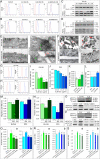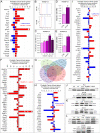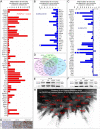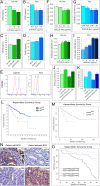CRISPR/Cas9-mediated deletion of Interleukin-30 suppresses IGF1 and CXCL5 and boosts SOCS3 reducing prostate cancer growth and mortality
- PMID: 36224639
- PMCID: PMC9559017
- DOI: 10.1186/s13045-022-01357-6
CRISPR/Cas9-mediated deletion of Interleukin-30 suppresses IGF1 and CXCL5 and boosts SOCS3 reducing prostate cancer growth and mortality
Abstract
Background: Metastatic prostate cancer (PC) is a leading cause of cancer death in men worldwide. Targeting of the culprits of disease progression is an unmet need. Interleukin (IL)-30 promotes PC onset and development, but whether it can be a suitable therapeutic target remains to be investigated. Here, we shed light on the relationship between IL30 and canonical PC driver genes and explored the anti-tumor potential of CRISPR/Cas9-mediated deletion of IL30.
Methods: PC cell production of, and response to, IL30 was tested by flow cytometry, immunoelectron microscopy, invasion and migration assays and PCR arrays. Syngeneic and xenograft models were used to investigate the effects of IL30, and its deletion by CRISPR/Cas9 genome editing, on tumor growth. Bioinformatics of transcriptional data and immunopathology of PC samples were used to assess the translational value of the experimental findings.
Results: Human membrane-bound IL30 promoted PC cell proliferation, invasion and migration in association with STAT1/STAT3 phosphorylation, similarly to its murine, but secreted, counterpart. Both human and murine IL30 regulated PC driver and immunity genes and shared the upregulation of oncogenes, BCL2 and NFKB1, immunoregulatory mediators, IL1A, TNF, TLR4, PTGS2, PD-L1, STAT3, and chemokine receptors, CCR2, CCR4, CXCR5. In human PC cells, IL30 improved the release of IGF1 and CXCL5, which mediated, via autocrine loops, its potent proliferative effect. Deletion of IL30 dramatically downregulated BCL2, NFKB1, STAT3, IGF1 and CXCL5, whereas tumor suppressors, primarily SOCS3, were upregulated. Syngeneic and xenograft PC models demonstrated IL30's ability to boost cancer proliferation, vascularization and myeloid-derived cell infiltration, which were hindered, along with tumor growth and metastasis, by IL30 deletion, with improved host survival. RNA-Seq data from the PanCancer collection and immunohistochemistry of high-grade locally advanced PCs demonstrated an inverse association (chi-squared test, p = 0.0242) between IL30 and SOCS3 expression and a longer progression-free survival of patients with IL30NegSOCS3PosPC, when compared to patients with IL30PosSOCS3NegPC.
Conclusions: Membrane-anchored IL30 expressed by human PC cells shares a tumor progression programs with its murine homolog and, via juxtacrine signals, steers a complex network of PC driver and immunity genes promoting prostate oncogenesis. The efficacy of CRISPR/Cas9-mediated targeting of IL30 in curbing PC progression paves the way for its clinical use.
Keywords: CRISPR/Cas9; CXCL5; IGF1; Interleukin-30; Prostate cancer; Tumor microenvironment.
© 2022. The Author(s).
Conflict of interest statement
The authors declare that they have no competing interests.
Figures






References
-
- GBD 2017 Disease and Injury Incidence and Prevalence Collaborators Global, regional, and national incidence, prevalence, and years lived with disability for 354 diseases and injuries for 195 countries and territories, 1990–2017: a systematic analysis for the Global Burden of Disease Study 2017. Lancet. 2018;392(10159):1789–1858. doi: 10.1016/S0140-6736(18)32279-7. - DOI - PMC - PubMed
-
- Pflanz S, Timans JC, Cheung J, Rosales R, Kanzler H, Gilbert J, Hibbert L, Churakova T, Travis M, Vaisberg E, et al. IL-27, a heterodimeric cytokine composed of EBI3 and p28 protein, induces proliferation of naive CD4+ T cells. Immunity. 2002;16(6):779–790. doi: 10.1016/S1074-7613(02)00324-2. - DOI - PubMed
Publication types
MeSH terms
Substances
LinkOut - more resources
Full Text Sources
Medical
Research Materials
Miscellaneous

